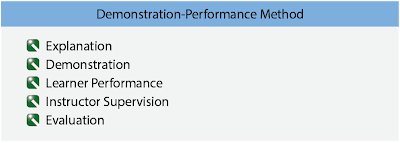Best used for the mastery of mental or physical skills that require practice, the demonstration-performance method is based on the principle that people learn by doing. In this method, learners observe the skill and then try to reproduce it. It is well suited for the aircraft maintenance instructor who uses it in the shop to teach welding, and the flight instructor who uses it in teaching piloting skills.
Every instructor should recognize the importance of learner performance in the process. Early in demonstration and performance lesson, the instructor should identify the most important learning outcomes. Next, explain and demonstrate the steps involved in performing the skill being taught. Then, allow learners time to practice each step, so they can increase their ability to perform the skill.
The demonstration-performance method is divided into five phases: explanation, demonstration, learner performance, instructor supervision, and evaluation. [Figure]
 |
| The demonstration-performance method of teaching has five essential phases |
Explanation Phase
Explanations need to be clear, pertinent to the objectives of the particular lesson to be presented, and based on the known experience and knowledge of the learners. In teaching a skill, the instructor conveys to the learners the precise actions they are to perform. In addition to the necessary steps, the instructor should describe the end result of these efforts. Before leaving this phase, the instructor should encourage learners to ask questions about any step of the procedure that they do not understand.
Demonstration Phase
The instructor shows learners the actions necessary to perform a skill. Extraneous activity should be excluded from the demonstration so that learners clearly understand the desired actions. If the demonstration deviates from the explanation, this deviation should be immediately acknowledged and explained.
Learner Performance and Instruction Supervision Phases
While they involve separate actions, the learner’s performance of the physical or mental skills that and the instructor’s supervision occur at the same time.
The instructor needs to allot enough time for meaningful activity. Through doing, learners learn to follow correct procedures and to reach established standards. It is important that learners be given an opportunity to perform the skill as soon as possible after a demonstration. In flight training, the instructor may allow the learner to follow along on the controls during the demonstration of a maneuver. Immediately thereafter, the instructor should have the learner attempt to perform the maneuver, coaching as necessary. In the opening scenario, learners performed a task (weight and balance computation) as a group, and prior to terminating the performance phase, they were allowed to independently complete the task at least once with supervision and coaching as necessary.
Evaluation Phase
In this phase, the instructor judges learner performance. The learner displays whatever competence has been attained, and the instructor identifies how well the skill has been mastered. To test performance ability, the instructor requires learners to work independently throughout this phase and makes some comment about how each performed the skill relative to the way it was taught. From this measurement of learner achievement, the instructor determines the effectiveness of the instruction.
